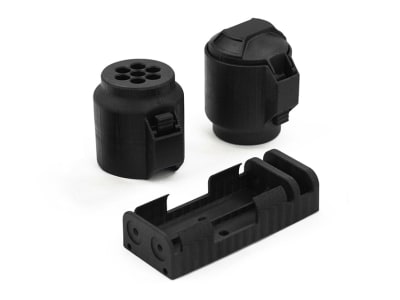
In certain environments, fire is a risk. To help prevent it or to limit the spread of fire, and therefore provide operators additional time to ensure their safety, flame-retardant materials are essential.
Despite their importance, flame-retardant materials are not largely developed for the variety of AM technologies that are used on the market. So far, most flame-retardant materials are developed for FDM 3D printing and SLS 3D printing. 3D printing company Carbon expands the capabilities of DLS 3D printing with the addition of a flame retardant photopolymer resin.
The announcement follows the recent announcement of the company’s M3 Series and the availability of the Carbon Design Engine™ as the company further enhances its idea-to-production platform.
Named EPX 86FR, the photopolymer resin would deliver a combination of flame retardance, functional toughness, high strength, and long-term stability. It can help reduce development time and tooling costs for end-use parts, functional prototypes, and tools that require flame-retardant and self-extinguishing features, such as housings, brackets, and connectors in the automotive and industrial sectors, Carbon notes in a press communication.
The new material delivers properties similar to Carbon’s high-strength epoxy-based engineering material, EPX 82, with better accuracy from reduced warpage and higher green strength. Those properties include functional toughness and temperature stability.
Developed “for industries and markets that require a V-0 flame rating, high performance mechanical properties, and smooth surface quality in a reliable, consistent, and high throughput printing platform”, the first company that testifies to the capabilities of this material is Astoria Pacific, a company that manufactures automated analysis solutions for laboratories.
They utilize Carbon’s new material for the development of heat bath housings for highly regulated electronics devices, among other applications.
“We encountered significant supply chain delays in sourcing PVC and sheet metal,” said Whitney Menzel, Senior Engineer at Astoria Pacific. “We turned to Carbon’s platform and extensive material lineup, including EPX 86FR, to mitigate these challenges. Not only did we experience a much shorter production time frame using the flame-retardant resin–from 18 weeks through traditional methods to 2 weeks utilizing Carbon’s platform–but we also saw significant cost savings, enhanced surface finishes, reduced weight, and both thermal and mechanical advantages.”
Ideal for applications that require UL 94 V-0 or FAR 25.853(a) ratings with flame-retardant and self-extinguishing features, EPX 86FR can help achieve electronics device battery housings, fans, circuit board covers, automotive battery cases, brackets, covers, fasteners, cable clips, and connectors.
Remember, you can post job opportunities in the AM Industry on 3D ADEPT Media free of charge or look for a job via our job board. Make sure to follow us on our social networks and subscribe to our weekly newsletter: Facebook, Twitter, LinkedIn & Instagram ! If you want to be featured in the next issue of our digital magazine or if you hear a story that needs to be heard, make sure you send it to contact@3dadept.com





